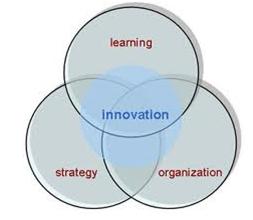Innovation is acute for day to day performance and long-lasting survival of companies. This importance places innovation at the core of any company, and subsequently creates a need to develop systemic innovation, where a climate of learning helps to understand how and where to focus on your innovation efforts (Thomas, 2006). Figure 1 shows how innovation is the result of the interception of the organization with its strategies and its desire for becoming a learning entity.

Mitra (2000) suggests that these innovation efforts are triggered by needs such as cost reduction, value added, and new market opportunities which have made organizations more aware not only of creativity but also of the need of a systemic innovation learning process.
Kuhn and Marsick (2005) remark that the learning process oriented to innovation posses three characteristics: (1) has to be part of the strategy development process, (2) has to be capable of transforming, and (3) reaches not only individuals but masses to create groups of learning leaders that support innovation as a fundamental company value and help other to engage in the innovation culture.
These leaders have to learn how to work in environments where diversity is a characteristic, also have to feel comfortable about making mistakes and learning from those mistakes without being punished and finally, to truly create a systemic innovation learning process, they have to be able to reproduce their experiences to lead and manage others (Kuhn and Marsick, 2005).
This increasing awareness about the need of innovation oriented learning process has contributed to the proliferation of teaching to support innovation. Figure 2 shows Innovation and learning has become a perspective in the balance score card for companies who are becoming aware that innovation is a fundamental for success.

Jorgensen and Busk (2007) and Hesselbein et al (2002) had pointed out that today, more than ever, students need to learn, practice and experience tools and methods to develop innovative capabilities that will help them to face the challenges of innovation into their own working environments; however literature shows that although innovation teaching is a need, the education on the innovation field is small. Most of the efforts in academia have been focused in entrepreneurship teaching rather than innovation teaching. By 2008 this entrepreneurship education in US offered around 2200 courses in more the 1600 education institutions. (Harkema and Schout 2008, Fayolle and Gailly 2008 and Kuratko 2005).
In response to the initial question, yes, innovation teaching is important. This teaching will give individuals the skills to think out of the box in day to day situations where creativity must become innovation to help our organizations to remain successful.
References
-
Fayolle, A. and Benoit, G. (2008), “From craft to science. Teaching models and learning processes in entrepreneurship education”, Journal of European Industrial Training, Vol.32 No.7, pp: 569-593.
-
Harkema, S. and Schout, H. (2008), “Incorportaing Student-Centered learning in innovation and entrepreneurship education”, European Journal of Education, Vol.43 No.4, pp: 513-526.
-
Hesselbein, F., Goldsmith, M. and Somerville,I. (2002), Leading Results Innovation and Organizing for results, Jossey-Bass, California.
-
Jorgensen, F. and Busk, L. (2007), “Integrating the development of continuous improvement and innovation capabilities into engineering education”, European Journal of Engineering Education, Vol.32 No.2, pp: 181-191.
-
Kuhn, J. and Marsick, V. (2005), “Action learning for strategic innovation in mature organizations: key cognitive, design and contextual considerations”, Active Learning: Research and Practice, Vol.2 No.1, pp: 27-48.
-
Kuratko, D. (2005), “The emergence of entrepreneurship education: applying the theory of planned behavior”, Entrepreneurship Theory and Practice, Vol.29 No.5, pp: 577-597.
-
Mitra, F. (2000), “Making connections: Innovation and collective learning in small business”, Education and training, vol.42 No.4&5, pp: 228-236.
-
Robinson, M. (2010) retrieved from http://blog.pfmresults.com/wordpress/?p=82 on November 16th, 2010.
-
Thomas, A. (2006). Disciplined Innovation. Excellence is a habit. Leadership Excellente. 23(7): 6.
